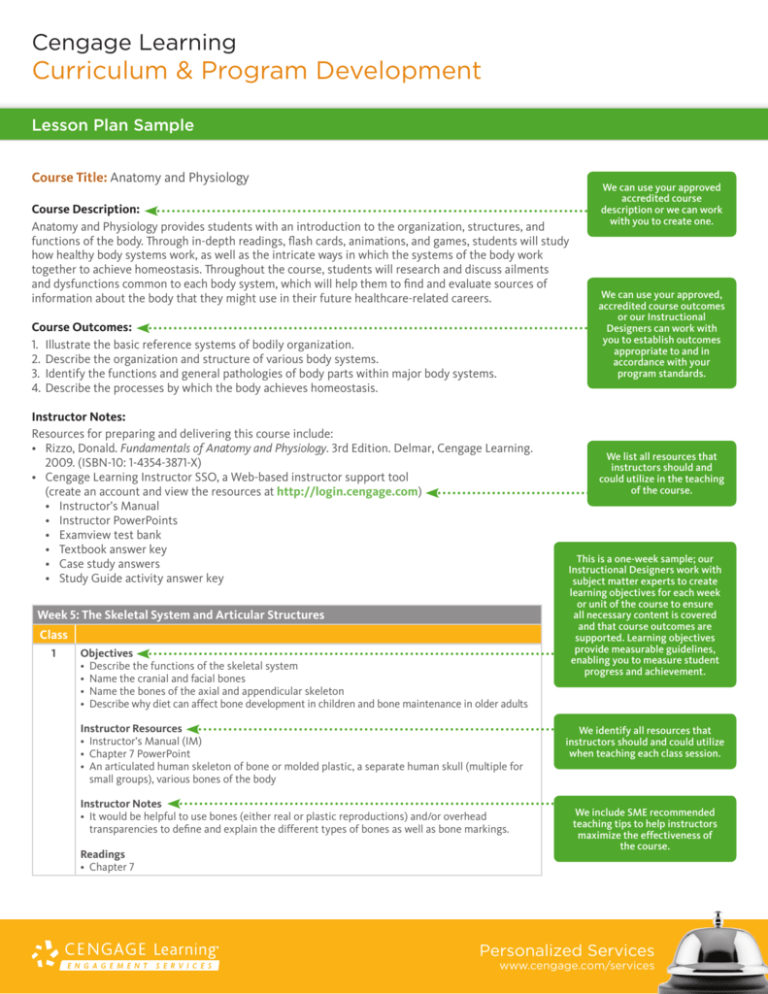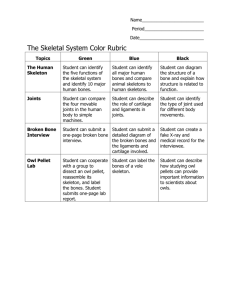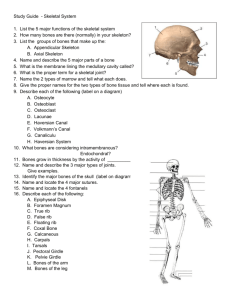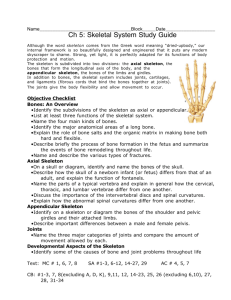
Cengage Learning
Curriculum & Program Development
Lesson Plan Sample
Course Title: Anatomy and Physiology
Course Description:
Anatomy and Physiology provides students with an introduction to the organization, structures, and
functions of the body. Through in-depth readings, flash cards, animations, and games, students will study
how healthy body systems work, as well as the intricate ways in which the systems of the body work
together to achieve homeostasis. Throughout the course, students will research and discuss ailments
and dysfunctions common to each body system, which will help them to find and evaluate sources of
information about the body that they might use in their future healthcare-related careers.
Course Outcomes:
1. Illustrate the basic reference systems of bodily organization.
2. Describe the organization and structure of various body systems.
3. Identify the functions and general pathologies of body parts within major body systems.
4. Describe the processes by which the body achieves homeostasis.
Instructor Notes:
Resources for preparing and delivering this course include:
• Rizzo, Donald. Fundamentals of Anatomy and Physiology. 3rd Edition. Delmar, Cengage Learning.
2009. (ISBN-10: 1-4354-3871-X)
• Cengage Learning Instructor SSO, a Web-based instructor support tool
(create an account and view the resources at http://login.cengage.com)
• Instructor’s Manual
• Instructor PowerPoints
• Examview test bank
• Textbook answer key
• Case study answers
• Study Guide activity answer key
Week 5: The Skeletal System and Articular Structures
Class
1
Objectives
• Describe the functions of the skeletal system
• Name the cranial and facial bones
• Name the bones of the axial and appendicular skeleton
• Describe why diet can affect bone development in children and bone maintenance in older adults
Instructor Resources
• Instructor’s Manual (IM)
• Chapter 7 PowerPoint
• An articulated human skeleton of bone or molded plastic, a separate human skull (multiple for
small groups), various bones of the body
Instructor Notes
• It would be helpful to use bones (either real or plastic reproductions) and/or overhead
transparencies to define and explain the different types of bones as well as bone markings.
Readings
• Chapter 7
We can use your approved
accredited course
description or we can work
with you to create one.
We can use your approved,
accredited course outcomes
or our Instructional
Designers can work with
you to establish outcomes
appropriate to and in
accordance with your
program standards.
We list all resources that
instructors should and
could utilize in the teaching
of the course.
This is a one-week sample; our
Instructional Designers work with
subject matter experts to create
learning objectives for each week
or unit of the course to ensure
all necessary content is covered
and that course outcomes are
supported. Learning objectives
provide measurable guidelines,
enabling you to measure student
progress and achievement.
We identify all resources that
instructors should and could utilize
when teaching each class session.
We include SME recommended
teaching tips to help instructors
maximize the effectiveness of
the course.
Personalized Services
www.cengage.com/services
Cengage Learning
Curriculum & Program Development
Lesson Plan Sample
Week 5: The Skeletal System and Articular Structures
Class
1
In-Class Activities
• Use the Chapter 7 PowerPoint to introduce and discuss the skeletal system:
• Introduce the system as the supporting structure of the body that provides levers for muscles
to pull on, resulting in movement.
• Discuss the five general functions of the system—support, protection, movement, blood cell
production, and storage.
• Discuss ossification, bone maturation and remodeling, the protein matrix of bone, and the
mineral salts in that matrix.
• Use a visual aid showing structures of osteoblasts and osteocytes; discuss the role of
osteoclasts in remodeling.
• The axial skeleton: Illustrate all parts, using a skull to show cranial and facial bones.
• Critical thinking questions for classroom discussion:
• Discuss why certain bones of the body are stronger with more compact bone than others.
• Discuss why the supply of blood cells in the body is dependent, in part, on the skeletal system.
• In groups of four or five, have students complete the Laboratory Exercise (p. 173).
Homework
• Chapter 7 Case Study (p. 172)
• Chapter 7 Study Guide activities
• StudyWARE™ CD-ROM: Chapter 7 activities and games
• Read Chapter 8
• Chapter 8 review questions
We provide in-class activities
that give instructors the support
they need as they facilitate the
course, while ensuring credit hour
regulations are met.
Our team identifies the most
appropriate assessments and
assignments to support learning
objectives while ensuring content
meets credit hour regulations and
your guidelines.
Graded Assignments
•None
2
Objectives
• Name and describe the three types of joints
• Describe and give examples of the types of synarthroses, amphiarthroses and diarthroses joints
• Describe the three types of bursae
• Name some of the disorders of joints
• Describe the possible movements at synovial joints
Instructor Resources
• Instructor’s Manual (IM)
• Chapter 8 PowerPoint
• Video on the anatomy of human joints
• An articulated human skeleton, anatomic models of the shoulder joint and hip joint (multiple for
small groups)
Readings
• Chapter 8
In-Class Activities
• Use the Chapter 8 PowerPoint to introduce and discuss the articular system
• Introduce the fact that an articulation is a place of union between two or more bones
regardless of the degree of movement, hence the name of the system (articular).
• Explain how joints can be classified based on the degree of movement they allow (function)
and the type of material that holds the bones together (structure).
• Define flexion and extension, hyperextension, dorsiflexion, and plantar flexion of the foot,
abduction and adduction, rotation, circumduction, supination, and pronation of the hand,
eversion and inversion, protraction, retraction, elevation, depression, opposition, and
reposition. Have students do these movements.
• Critical thinking questions for classroom discussion:
• Compare the nature of the three types of joints; relate this to structure and function.
Personalized Services
www.cengage.com/services
Cengage Learning
Curriculum & Program Development
Lesson Plan Sample
Week 5: The Skeletal System and Articular Structures
Class
2
• Discuss what the term capsule means referring to a synovial joint.
• Discuss why bursae must be part of a synovial joint.
• In groups of four or five, have students complete the Laboratory Exercise (p. 189).
• Show video on anatomy of human joints
Homework
• Chapter 8 Case Study (p. 188)
• Chapter 8 Study Guide activities
• StudyWARE™ CD-ROM: Chapter 8 activities and games
• Read Chapter 9
• Chapter 9 review questions
Graded Assignments
• Week 5 Quiz (Chapters 7 and 8)
©2014 Cengage Learning. All Rights Reserved. 14P-IN0227
Personalized Services
www.cengage.com/services







